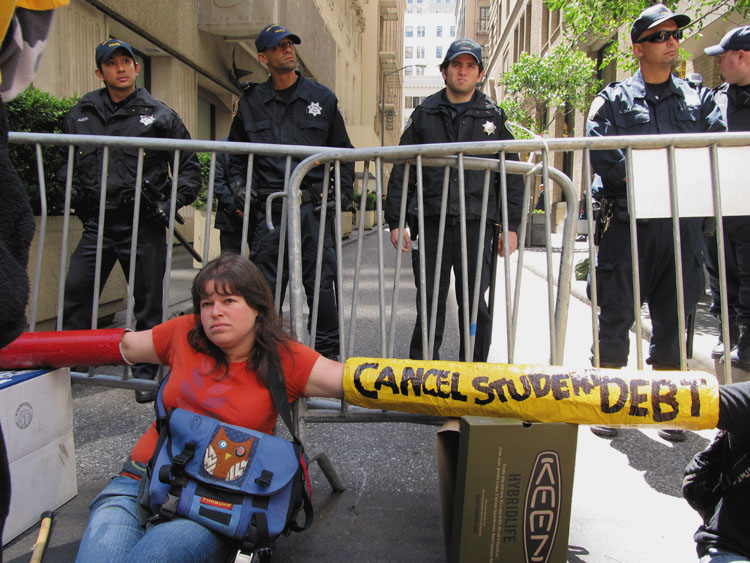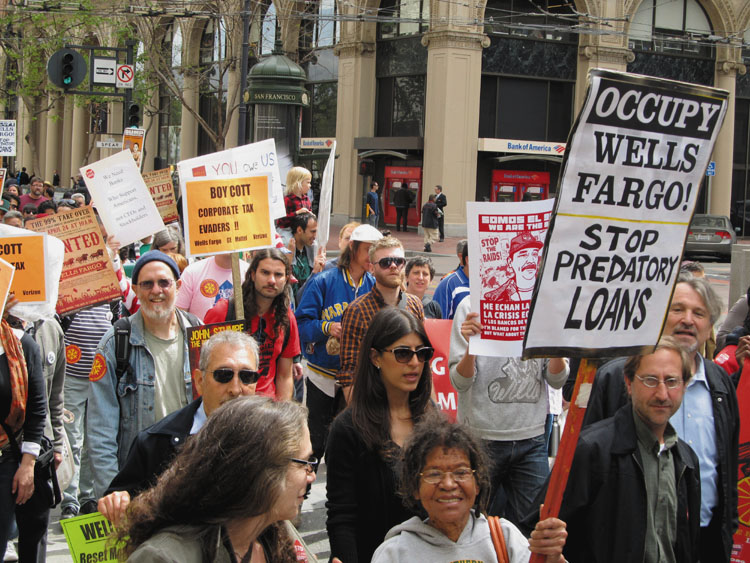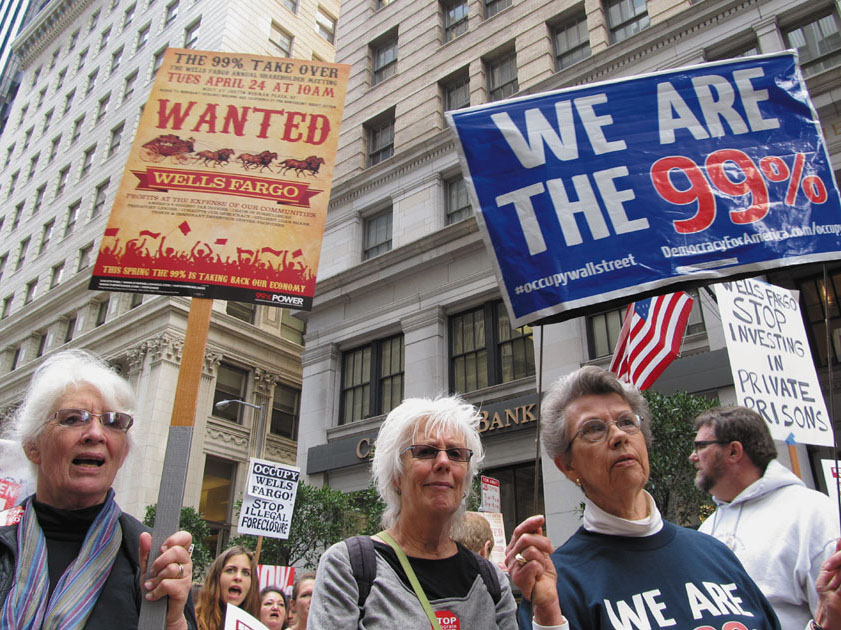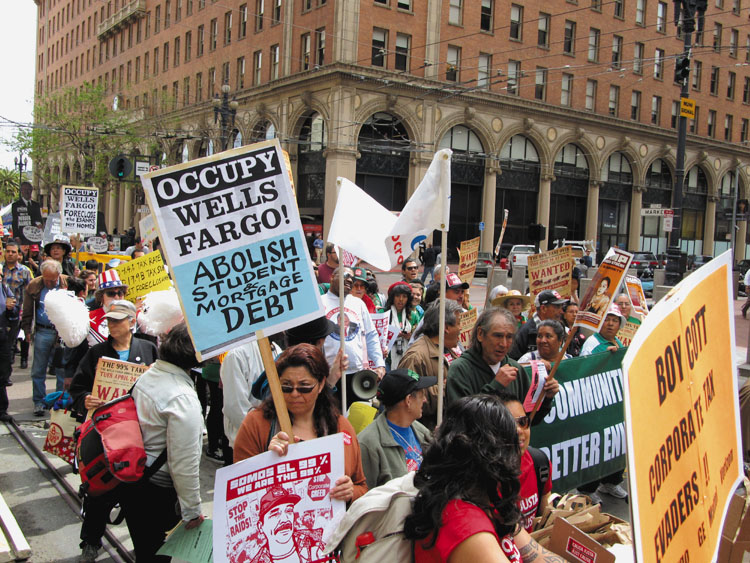
by Ariel Messman-Rucker
[dropcap]P[/dropcap]rotesters angry over the unjust economic divide in the United States came from all over the Bay Area and disrupted business as usual at Wells Fargo’s annual shareholders meeting on April 24 in San Francisco.
Approximately 2,000 demonstrators marched from Justin Herman Plaza — the epicenter of the Occupy SF movement last fall — and converged on the Merchants Exchange Building in downtown San Francisco where about 250 shareholders gathered on the 15th floor to hear Wells Fargo CEO John Stumpf report on the bank’s $15.9 billion profits from 2011.
Protesters shut down nearby streets, sat down and chained themselves together at the entrances to the shareholders meeting, and set up a makeshift stage in front of Wells Fargo on the back of a flatbed truck where labor groups, Occupiers, activists and religious leaders spoke to the crowd.

“Come out and hold your shareholder meeting with the 99 percent! Come hold your meeting with the people,” shouted speaker Tanya Dennis, who is a leader with the Home Defenders League, a group of underwater homeowners fighting banks across the country.
Energetic protesters filled the streets, shouting “Embargo Wells Fargo!” and “We are the 99 percent, let us in!” They brandished hundreds of signs with slogans reading “Occupy Wells Fargo,” “Stop Predatory Loans,” “Abolish Student and Mortgage Debt,” and “Foreclose the Banks Not Homes.”
More than 150 protesters bought shares of Wells Fargo stock or had proxy statements and attempted to gain entrance to the shareholders meeting so they could confront bank executives about Wells Fargo’s role in the current financial crisis, the high number of foreclosures that are reducing American families to homelessness, and its investment in private prisons.
The police blocked off entrances to the building and most protesting shareholders were turned away, even though they had a legal right to attend the annual meeting.
“I thought it was important to protest,” said Rev. Dr. Mario Howell, who spoke at the demonstration after being turned away and denied entrance at the shareholders meeting, even though he had bought a share of Wells Fargo stock so he could make his voice heard by bank officials.
“I’m here today not just by myself ready to go to jail, but over a hundred people are ready to go to jail today and obviously Wells Fargo didn’t let us in,” Rev. Howell said.

Howell, pastor of Antioch Church Family, said he has lost many members of his congregation because high housing costs and ever-increasing foreclosures have driven people away from Antioch.
“They have lost their hope, and when fear sets in, then their faith is dominated by their fear and that’s pretty bad,” he said. “So my church went from several hundred down to about a hundred because the people have lost their homes, have moved away from Antioch. Their dream homes have become a nightmare.”
Howell was arrested at last year’s Wells Fargo’s shareholders meeting with a group of outraged homeowners and community advocates who entered the meeting and refused to leave.
In a reference to Wells Fargo’s use of the stagecoach as its corporate symbol, Rev. Howell told the crowd, “People used to rob the stagecoach. Now the Wells Fargo stagecoach is robbing us!”

Activists were not only protesting Wells Fargo’s overpaid banking executives, predatory loans practices and its role in increasing the economic gap between the richest and poorest, but also for investing in for-profit, private-prison companies.
Wells Fargo profits from the private prison industry through its 7.24 percent stake in the GEO Group, one of the world’s largest detention organizations, according to Stopwellsfargo.com.
Peter Cervantes-Gautschi, executive director of Enlace and the National Prison Divestment Campaign, came to the protest to demand that Wells Fargo stop financing the private prison industry, but police wouldn’t let him inside the shareholders meeting.
“If we’re going to have a humane system and any kind of justice, the financial industry led by these giants like Wells Fargo have got to stop propping the private prison industry up, which is in essence dictating our immigration policy,” Cervantes-Gautschi said. “It’s inhumane and has to stop,”
Some protesters with Wells Fargo shares were eventually allowed into the meeting, but 15 were arrested while inside and nine more were arrested outside, according to Occupy San Francisco.
Other demonstrators chained themselves together to block an entrance to the Merchants Exchange Building. They linked their arms through PVC pipes, making it nearly impossible for police to safely cut the shackles and arrest them.
“We’re here to stop the Wells Fargo shareholder meeting from going forward as long as they’re continuing to make money off of taking families’ homes away and saddling students with debt that they can’t pay,” union representative Sarah Norr said in an interview while chained to fellow protesters.
The problem isn’t just with big banks taking advantage of the 99 percent, but also with the nation’s leaders, she said.

“I think both parties have failed us in holding big banks accountable,” Norr said. “Both parties have just bailed out the big banks and left homeowners on their own, left students on their own. So it’s time for us to take things into our own hands.”
Real estate broker Guadalupe Schmitt spoke out at the demonstration on behalf of the many homeowners she has seen lose their homes in foreclosures.
In an interview, Schmitt said, “I have worked with the community for over 20 years and I have seen how people have really struggled, families that have lost everything they ever had, who believe in the system and went and bought properties they can’t afford because of the kind of loans that they got. And I think these loans were really designed to fail.
“The people that really struggled are hard-working people, people that have been trying to work with the banks to keep their properties, and the banks have not yet listened to them.”
At the end of 2011, Wells Fargo & Co became the largest mortgage servicer in the nation with $1.82 trillion in loans serviced, according to Reuters.com.
Wells Fargo had $17.5 billion worth of foreclosures on its books as of June 2010, according to Stopwellsfargo.com.
Protesters used images of Wells Fargo CEO John Stumpf as a symbol of the unjust practices of the banking behemoth. Demonstrators held signs with his image emblazoned with phrases like “Wall St. Robber Banker,” “They get rich, our community gets poor,” and “They get rich, we lose homes, schools, services.”
The Wells Fargo shareholders meeting went forward despite the protest, electing 15 new directors and approving a $19.8 million compensation plan for Stumpf.
Jeremy Cutler, 19, came to participate in the demonstration because he’s angry that families like his are being forced out of their homes by banks like Wells Fargo.
Cutler was forced to drop out of middle school after his family home was foreclosed on. He has never been able to go back to school and now lives in a homeless shelter.
“My family lost their home in foreclosure and we’ve been bouncing around the country ever since,” he said. “We have no place to stay.”
